Tap Into Your Water: Transform Care and ROI

Water is not just a utility in healthcare. It is a critical part of patient safety, operational performance, and financial stability. Yet, for many organizations, water risk remains hidden until it leads to a costly disruption or outbreak. For healthcare leaders, managing water is a strategic decision that protects patients, strengthens compliance, and safeguards margins. With a proactive, multi-barrier water management approach, hospitals can turn water into an asset that drives safety, resilience, and return on investment. Patient safety and experience Clean water drives safer care and better outcomes The challenge Waterborne pathogens like Legionella, Pseudomonas, and nontuberculous mycobacteria (NTM) are an often-overlooked source of healthcare-associated infections (HAIs). According to research, water can be a source for more than 20% of HAIs. These infections compromise patient safety, erode trust, and negatively affect patient experience scores such as HCAHPS. For healthcare, every infection linked to water systems represents both a human risk and a reputational liability. The impact Waterborne HAIs increase length of stay, reduce capacity, and can cause value-based reimbursement penalties. They can also create negative headlines that damage community trust and competitive standing. Over time, financial and reputational costs compound, diverting resources from growth, innovation, and patient care. The solution LiquiTech reduces infection risks at the source with a multi-barrier approach that removes sediment, eliminates pathogens, prevents regrowth, and protects plumbing infrastructure. This extends the life of water-bearing equipment, reduces energy inefficiencies, and creates a safer environment for patients and staff. Proactive protection helps preserve infrastructure, deliver better outcomes, safeguard reputation, and reduce operating costs. Financial margin protection Safety delivers measurable ROI The challenge Shrinking margins, labor pressures, and rising operational costs leave little room for unplanned crises. A single outbreak or infrastructure failure can drain millions in unbudgeted expenses and force capital reallocation away from strategic priorities. The impact Emergency remediation, litigation, reputational damage, and lost revenue from closed units or diverted patients all strain budgets. Premature infrastructure replacement or plumbing repairs further erode financial stability. These avoidable costs undermine investments in technology, workforce development, and patient care innovation. The solution LiquiTech protects financial margins by preventing outbreaks and extending the life of plumbing systems and equipment. Our solutions reduce emergency remediation, lower energy inefficiencies, and cut premature replacement costs. By reducing the total cost of risk, we free up capital to reinvest in advancing patient care, enhancing staff resources, and strengthening long-term financial performance. Regulatory compliance Compliance you can prove The challenge Organizations such as the Joint Commission, CMS, DNV, and ASHRAE require defensible water management programs with governance, monitoring, and testing. Without a comprehensive, verifiable plan, healthcare organizations face serious compliance gaps and increased risk during survey. The impact Survey failures can result in penalties, fines, or even loss of accreditation. Beyond the immediate financial consequences, non-compliance undermines leadership credibility and disrupts reimbursements. Gaps in documentation create unnecessary stress for staff and leadership alike. The solution LiquiTech designs and manages tailored water management programs aligned with every requirement. With monitoring, testing, and defensible reporting, you are always survey-ready, not just during inspections. This transforms compliance from a liability into a source of leadership confidence, reducing risk and freeing staff to focus on patient care. Enterprise risk and resilience Resilient hospitals start with resilient water The challenge Hospital operations rely on water for every function, from sterile processing to patient care. Yet risks often remain invisible until a crisis occurs. Outbreaks, pipe failures, or contamination events can rapidly shut down units and disrupt continuity of care, destabilize operations, and tarnish brand reputation for an entire organization. The impact Service interruptions force diversions, cancel procedures, and undermine trust with patients, staff, and communities. Each incident risks regulatory investigations, lawsuits, and reputational harm. When water systems fail, organizational resilience and the ability to deliver reliable care are compromised. The solution LiquiTech builds resilience into water systems with smart monitoring, rapid-response playbooks, and preventive strategies. By detecting risks early and ensuring infrastructure reliability, disruptions are minimized, equipment life is extended, and energy inefficiencies are reduced. This proactive approach ensures uninterrupted care, reputation, and operational resilience even when external pressures mount. Sustainability and ESG Safer for patients, smarter for the planet The challenge Hospitals face rising expectations to meet ESG goals while protecting patients and infrastructure. Traditional chemical treatments introduce harmful byproducts, accelerate corrosion, and increase energy demand and long-term costs, all while putting sustainability at odds with safety. The impact Chemical approaches are outdated, drive premature system failures, raise energy consumption, and create environmental hazards. They also raise concerns from patients, staff, and communities who expect environmentally responsible care. Failing to adopt sustainable practices risks reputational harm and higher operational costs. The solution LiquiTech’s multi-barrier approach eliminates pathogens without harmful byproducts. By reducing corrosion, extending equipment life, and lowering energy use, we protect both people and infrastructure. Our solutions help hospitals meet ESG goals while delivering safer, smarter, and more sustainable care. Tap into the hidden potential of water Water touches every part of your healthcare system, from patient safety and compliance to finances and sustainability. By managing it strategically, you can transform an overlooked operational risk into a driver of measurable improvement and resilience. LiquiTech’s multi-barrier solutions empower healthcare leaders to strengthen water safety, reduce costs, and protect their facilities for the future. It is time to take a proactive step Connect with our team today to learn how smarter water management can help your organization achieve safer care, stronger performance, and better ROI.
The Broader Impact of Effective Water Management

Water safety is often focused only on Legionella control, but an effective program can provide a much wider range of benefits. Water quality influences not only occupant health but also the performance of infrastructure, long-term sustainability goals, and financial outcomes. When facilities rely on outdated or incomplete water management strategies, they leave themselves vulnerable to risks that go well beyond Legionella. A smarter approach, grounded in a multi-barrier water management strategy, offers a way to protect people, extend equipment life, reduce operational costs, and support sustainability. Why traditional water treatment methods fall short Many facilities continue to lean on conventional practices such as flushing, temperature monitoring, and municipal disinfectant residuals. While these measures are widely used, they rarely address the real drivers of waterborne pathogen risk. Biofilm and sediment shield bacteria from disinfectants, temperature control is ineffective, cold water risks are overlooked, and flushing programs often require significant time and energy without producing lasting results. The cycle of monitoring and corrective actions that results from these methods is not just inefficient; it can mask bigger problems, such as hidden sediment accumulation or corrosion that undermines water quality throughout a building. The overlooked role of sediment Sediment is an underestimated challenge in building water systems. Sediment is naturally present in source water and often introduced through water main breaks, construction activity, or corrosion within pipes. Once inside, it quietly disrupts both water quality and infrastructure: Sediment-induced damage Broader impacts on facilities Poor water management is not just a safety concern; it affects every part of a facility’s operation. This interconnected risk landscape is why leading facilities are rethinking their approach with multi-barrier solutions that go beyond Legionella and compliance. Smarter water management A multi-barrier approach layers proven technologies with expert service to create a comprehensive, defensible water management strategy. Together, these measures protect both people and infrastructure: These technologies are integrated into a program supported by data analytics and remote monitoring, ensuring that facility teams can act proactively instead of reactively. Real-world results The benefits of this approach are measurable. In one academic medical center, implementing a multi-barrier solution allowed hot water heaters to be lowered from 160°F to 125°F while still achieving non-detect Legionella results, cutting energy use by 50%. Another facility reduced sediment loads by nearly 98%, preventing costly pump failures and improving system reliability. Even more importantly, infection risk was significantly reduced. One facility saw complete elimination of Pseudomonas, Acinetobacter, and Stenotrophomonas detections, improving patient safety and reducing the burden of HAIs. Rethink water safety for the future Water is more than a utility; it’s a clinical, operational, and financial risk factor. By addressing underlying issues like sediment and biofilm with smarter, layered protection, facilities can safeguard their people, extend equipment life, and achieve long-term results. If your current water management strategy feels like a cycle of short-term fixes, it may be time to take a smarter approach. Connect with a LiquiTech water safety expert today to explore how a multi-barrier strategy can transform your facility’s water quality and performance.
Multi-Barrier Approach: Setting a New Standard for Water Safety
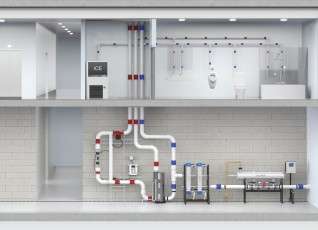
Healthcare facilities today face increasing water safety risks. Aging infrastructure, frequent water main breaks, and elevated sediment levels are straining plumbing systems and creating ideal conditions for waterborne pathogens to thrive. Municipal treatment processes, while essential, often don’t address these downstream challenges once water enters a facility. The result is a growing concern for occupant safety, equipment reliability, and compliance. One healthcare facility confronted these realities head-on after dealing with Legionella positivity in its cold-water system, as well as recurring detection of Pseudomonas, Acinetobacter, and Stenotrophomonas. Beyond microbial risks, high sediment loads from the municipal water supply were causing significant damage to plumbing infrastructure, increasing maintenance costs, and accelerating corrosion. Traditional remediation approaches were unable to deliver sustainable results. The Challenge The facility needed a comprehensive strategy that could both eliminate pathogens and reduce the environmental conditions that allowed them to flourish. The solution: A multi-barrier approach To address these challenges, LiquiTech implemented a multi-barrier water treatment solution designed to deliver layered protection: Together, these technologies worked in synergy to address the root causes of water quality problems and provide sustained protection. The results By addressing microbial challenges, sediment-related damage, and infrastructure reliability together, the facility established a new standard of care for water safety. The solution not only safeguarded patients and staff but also delivered measurable operational and financial benefits. Connect with an expert Fill out the form below to connect with a LiquiTech expert to explore how a multi-barrier water treatment approach can help protect your facility’s water, systems, and ROI.
Healthcare Solutions: How to Reduce Waterborne Pathogen Risk

In healthcare settings, it is crucial to take every precaution to ensure patient safety and well-being, including the quality of water used throughout the facility. Waterborne pathogens, commonly present in building water systems, can pose serious health risks, particularly to individuals with weakened immune systems. This blog post will delve into common waterborne pathogens, their effects, and the preventive measures necessary to maintain safe water in healthcare environments. Understanding common waterborne pathogens and their impact Waterborne pathogens are microorganisms that thrive in water systems and can cause severe infections. Healthcare facilities, with their complex and extensive water systems, provide an ideal environment for these pathogens to proliferate. The presence of immunocompromised patients and the use of medical devices that rely on water further increase the risk of infections. Awareness and proactive management, including regular water testing, system maintenance, and the implementation of effective disinfection protocols, are essential to prevent outbreaks and protect patients and staff. Legionella Legionella bacteria can thrive in complex water systems, such as those found in hospitals. These bacteria can cause Legionnaires’ disease, a severe form of pneumonia. Legionella is primarily transmitted by inhaling small water droplets containing the bacteria, which can occur through showers, cooling towers, and decorative fountains. Aspiration of contaminated drinking water can also lead to infection. Regular assessment and maintenance of water systems are crucial to preventing Legionella growth. This includes routine cleaning and disinfection of cooling towers and decorative fountains. Copper-silver ionization, a method that continuously disinfects potable water, has proven effective in controlling Legionella populations. Having a robust outbreak response plan is essential. This includes rapid identification of suspected Legionnaires’ disease cases, patient testing, and environmental sampling for Legionella. Quick action can help contain the spread and prevent further infections. Pseudomonas Pseudomonas, particularly Pseudomonas aeruginosa, thrive in moist environments. It can be found on medical equipment and in water sources, posing significant risks to patients, especially those with weakened immune systems. In healthcare settings, Pseudomonas can lead to various infections, including pneumonia. Effective water management, monitoring, rigorous cleaning, and disinfection protocols are vital to controlling Pseudomonas. Regularly disinfecting sinks, showers, and medical devices that come into contact with water can significantly reduce the risk of infection. Ensuring that all equipment is thoroughly sterilized is also crucial. Healthcare providers should be vigilant for symptoms of Pseudomonas infections, particularly in critically ill or post-surgery patients. Early detection and prompt treatment can prevent complications and improve patient outcomes. Stenotrophomonas Stenotrophomonas maltophilia (S. maltophilia) is a growing concern in hospitals due to its multidrug resistance. This organism often causes healthcare-associated infections (HAIs), affecting patients with compromised immune systems or those with indwelling devices like catheters and breathing tubes. S. maltophilia’s resistance to many common antibiotics makes infections challenging to treat. Understanding its resistance patterns is crucial for effective treatment. Physicians must stay informed about the latest guidelines and treatment options. To limit the spread of S. maltophilia, implement effective water management strategies, perform strict environmental monitoring, and implement disinfection procedures. Hand hygiene and device sterilization play a significant role in preventing transmission. Regular audits and staff training can help maintain high hygiene standards. Acinetobacter Acinetobacter baumannii is notorious for its resilience against antibiotics. This highly antibiotic-resistant pathogen often affects patients in intensive care units (ICUs) or those with compromised immune systems, leading to severe infections. Rigorous infection control measures are necessary to combat Acinetobacter. This includes water management practices, regular handwashing, sterilizing equipment, and implementing isolation protocols for affected patients. Preventing outbreaks requires a coordinated effort from all healthcare staff. Proactive surveillance for Acinetobacter is critical. Regular screening and monitoring can help detect infections early. Judicious antibiotic use, guided by susceptibility testing, is also key to managing its spread and improving patient outcomes. Solutions for healthcare facilities Waterborne pathogens pose a significant threat to healthcare facilities, but with proper awareness, preventive measures, and a coordinated effort from all healthcare staff, their impact can be minimized. By understanding the risks and implementing effective strategies, like water management programs, regular maintenance of water systems, rigorous infection control protocols, and proactive surveillance, we can ensure safer water systems and improve patient and staff safety. Our solutions, including copper-silver ionization, are effective against a broad spectrum of pathogens, including those discussed here. Implementation of these strategies can significantly reduce the risk of infection from water sources. Learn more about how healthcare facilities partner with LiquiTech or contact us today to explore our water treatment solutions designed to protect your patients and staff.
The Future of Plumbing: Smart Technologies for Better Water Management

The plumbing industry is undergoing a technological transformation. Aging infrastructure, evolving regulations, and increasing health risks necessitate a shift toward smarter, data-driven water management solutions. These innovations can improve water quality, optimize system performance, and enhance occupant safety. This blog explores how smart plumbing technologies are shaping the future of building water systems, offering practical insights for implementation. Challenges facing building plumbing systems Source water quality often declines as it travels through a building’s plumbing system, impacted by factors like sediment, biofilm, temperature fluctuations, and disinfectant loss. Disruptive events—such as water main breaks, construction, or hydrant flushing—can stir up sediment and biofilm, introducing these contaminants into the building. Once inside, the situation can worsen due to aging infrastructure, inconsistent temperatures, and water stagnation. Pressure put on building water systems: Addressing these challenges requires proactive solutions grounded in strong water management principles. Key principles of effective water management A comprehensive water management strategy builds resilience, reduces risks, and ensures regulatory compliance. The core principles include: Risk assessment Control measures Monitoring and documentation Interventions and corrective actions These principles create a foundation for incorporating advanced smart technologies into plumbing systems. The role of smart technologies in building water management Smart technologies bring automation, real-time data, and predictive analytics to water management, making systems safer, more efficient, and easier to manage. Key innovations include: Smart sensors Programmable flushing devices Advanced water treatment technologies The following technologies offer real-time water management, adjusting automatically based on water conditions and ensuring optimal system performance. Benefits of smart plumbing systems The advantages of implementing smart plumbing technologies go beyond regulatory compliance: Get started with smart plumbing technologies Adopting smart technologies requires strategic planning. Here’s how to begin: Embracing the future of plumbing The plumbing industry is evolving, and smart technologies are leading the way. These tools empower facility managers and engineers to proactively address water system challenges, ensuring safer, more efficient, and compliant operations. Now is the time to invest in the future of water management. By adopting smart technologies, you can enhance occupant safety, optimize operations, and create resilient systems. Ready to step into the future? Contact LiquiTech today to explore how our smart technologies can transform your building’s water management.
“Spring is here—and so is Legionella risk,” warns expert
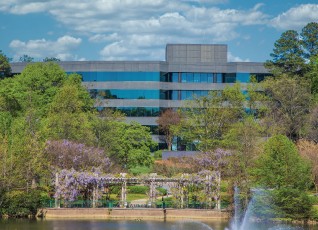
As the weather warms up, many healthcare facilities prepare for seasonal changes in staffing, patient volumes, and operations. But one area that often gets overlooked during this transition is your building water system—and spring can bring a perfect storm of conditions that elevate the risk of Legionella and sediment-related issues. “Spring is here—and so is Legionella risk,” says Dave Pierre, building water safety expert at LiquiTech. “Warmer temperatures, shifting water demand, and municipal activity like hydrant flushing create ideal conditions for both bacterial growth and sediment intrusion in building water systems.” Five spring risk factors impacting water safety Here are five reasons why spring poses increased water safety risks: Warmer weather raises cold water temps With rising outdoor temperatures, cold water lines—especially those in sun-exposed or poorly insulated areas—can warm into the ideal Legionella growth range (77–113°F). Even in well-designed systems, this shift can allow bacteria to multiply in areas not typically considered high-risk. UV disinfection on the incoming water supply can help kill bacteria before it enters your building, while systemic disinfection methods such as copper-silver ionization can prevent bacteria from growing and spreading in warm, low-flow areas within your plumbing. Together, these technologies offer a multi-barrier solution to address both external and internal risks. Seasonal water quality changes increase microbial activity Spring runoff and heavy rains can significantly impact source water quality by increasing turbidity, organic matter, and nutrient load in the municipal supply. These changes can strain municipal treatment processes and often result in lower chlorine residuals and increased microbiological activity in the water entering your facility. This weakens your first line of defense against waterborne pathogens like Legionella. UV disinfection helps reduce microbial load before it enters the building, while systemic disinfection technologies provide ongoing protection throughout your plumbing system. Municipal disruptions introduce sediment Spring is prime time for municipal hydrant flushing and water main repairs. These activities can stir up sediment and contaminants in the public water supply, which then make their way into your building. Sediment doesn’t just reduce disinfectant effectiveness—it can also feed bacterial growth, damage water-bearing equipment, and even lead to pipe leaks or system failures. Sediment filtration on the incoming water supply helps prevent sediment from entering the building, protecting plumbing infrastructure and supporting overall water quality. Changing demand patterns stress plumbing Spring often brings changes in how different parts of a facility use water. Higher demand from increased patient volumes, reopened services, or seasonal water systems (e.g., cooling towers, irrigation systems, and outdoor water features) can cause pressure fluctuations and temperature shifts that disturb biofilm and mobilize bacteria. On the flip side, lower or inconsistent usage in certain areas can lead to stagnation, loss of disinfectant residuals, and unchecked Legionella growth—especially in places like handwashing sinks or infrequently used showers. Smart sensors throughout the plumbing system can help monitor these changes in real time, identifying abnormal flow patterns, temperature inconsistencies, and other early warning signs of system imbalance—so you can take corrective action before issues escalate. Stagnant water in underused areas Units that saw minimal use during the winter—like seasonal wings, outpatient areas, or overflow rooms—may still have stagnant water sitting in the plumbing. Without proper flushing and maintenance, that water can harbor biofilm and Legionella, and turning those outlets back on can send contaminated water into patient areas. Point-of-use filters offer immediate protection at faucets and showers, while flushing protocols guided by your water management program can help clear stagnant water safely. What to do next Spring is the ideal time to review your water management plan and ensure it addresses seasonal risk factors like temperature fluctuations, sediment intrusion, and changing water use patterns. A targeted water system risk assessment can help identify vulnerabilities and confirm that your plan includes the right preventive measures—such as flushing procedures, filtration strategies, monitoring points, and disinfection methods—for this time of year. Making these updates now can help reduce the risk of Legionella growth, protect your patients, and prevent costly equipment damage tied to sediment and system imbalances. Need support evaluating your water management plan this spring? Our team of water safety experts is here to help, contact LiquiTech today.
Advancing Sustainability and Operational Efficiency in Healthcare

Water systems are critical to healthcare operations, but they also present significant challenges that affect energy use, infrastructure, and equipment performance. Issues like sediment buildup, biofilm formation, and poor system balance can drive up costs, waste energy, and compromise long-term sustainability. By addressing these challenges proactively, hospitals can improve efficiency, reduce expenses, and extend the lifespan of essential systems and equipment. Reducing energy waste Healthcare facilities rank among the most energy-intensive building types, with roughly 42.3% of their energy usage tied to reheating processes. Inefficient water systems—whether due to sediment buildup, poor insulation, or imbalanced flow—force pumps, boilers, and reheaters to work overtime. This increased workload leads to higher operating costs and strains organizational efforts to meet sustainability targets. By focusing on improvements in water quality and system design, hospitals can reduce energy consumption, cut costs, and extend the life of vital equipment. Key strategies include: Implementing sustainable water treatment technologies Advanced technologies that reduce contaminants and pathogens in building water improve safety, extend the lifespan of plumbing systems, and reduce the frequency of repairs, which helps conserve resources and reduce waste. Leveraging smart monitoring technologies Real-time monitoring tools have revolutionized water management strategies in healthcare. Smart sensors and remote monitoring technologies allow facilities to proactively identify and address inefficiencies, reduce waste, and maintain optimal conditions for patient care. Protecting water infrastructure for long-term sustainability Protecting the longevity of plumbing systems and water-bearing equipment is an often overlooked aspect of water management that significantly impacts sustainability. By preventing damage caused by sediment, corrosion, and scale, businesses can reduce the need for frequent repairs and replacements, lowering waste and extending the lifespan of their infrastructure. Supporting broader sustainability initiatives Water management is essential for organizations aiming to meet their broader sustainability objectives. Enhancing the efficiency of water infrastructure, reducing energy consumption, and adopting environmentally friendly water treatment technologies align with environmental, social, and governance goals. By leveraging advanced technologies and real-time monitoring, businesses can optimize water use, cut energy costs, conserve resources, and reduce carbon footprints, driving meaningful progress toward a sustainable future. Ready to get started? Contact LiquiTech today for a water management analysis to see how you can take your sustainability efforts to the next level.
Legionella: What Is It and How to Control It
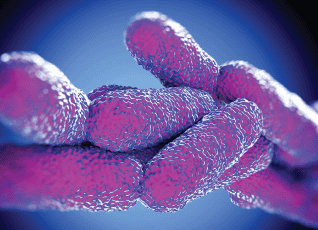
What is Legionella? Legionella is a bacterium that causes Legionnaires’ disease and Pontiac fever. It was named after the first known outbreak of Legionnaires’ disease in 1976 at an American Legion Convention. Legionnaires’ disease is a severe type of pneumonia. Pontiac fever is a less severe illness that typically resolves without hospitalization. Approximately 90% of Legionnaires’ disease cases are caused by Legionella pneumophila. Non-pneumophila species are responsible for fewer than 10% of cases. Where is it found? Legionella can be found in natural water sources. It can survive traditional municipal water treatment processes and be distributed to buildings from the municipal water supply. Once in building water systems, ideal conditions, like warm water, sediment, and other microorganisms, can cause it to proliferate. Potable water systems, especially hot water systems, are the highest concern for Legionella growth and transmission. High-risk non-potable systems include cooling towers, decorative water features, whirlpools, spas, and misters. More than half of outbreaks occur in healthcare facilities. Outbreaks have also been linked to nursing homes, hotels, workplaces, apartment complexes, and community sources. What are the health concerns? Legionnaires’ disease can be contracted through exposure to contaminated water, usually via inhalation of aerosolized particles or aspiration. Cases have also been linked to direct installation, such as nasogastric tubes. People with weakened immune systems, chronic lung disease, diabetes, cancer, transplants, steroid use, and the elderly are at higher risk of contracting the disease. However, roughly 25% of cases have no known risk factors. More than 95% of cases require hospitalization, and more than 30% require admission to the ICU. The disease fatality rate is over 10%. Healthcare facilities are the most common exposure setting, accounting for 57% of cases and 85% of deaths. How can Legionella be controlled? There are many strategies to reduce Legionella risk in building water systems. To start, Legionella testing should be conducted to identify if and where Legionella is present in the water system so evidence-based remediation strategies can be implemented. Continuous supplemental disinfection can be installed to remediate the entire water system and provide long-term Legionella control. The most effective is copper-silver ionization. It is highly effective against Legionella and other waterborne pathogens and does not have any negative side effects, like corrosion or harmful disinfection byproducts. Short-term remediation options, like chlorine shock treatments, have varying efficacy. If Legionella reduction is achieved, it is typically short-lived. Point-of-use filters can be installed on faucets, showerheads, and ice machines to prevent exposure to Legionella and other waterborne pathogens. However, they do not remediate the water system and require ongoing maintenance and costs, so they are usually deployed temporarily or in high-risk units. Engineering controls like circulation, flushing, and temperature can prevent favorable conditions but do not fully mitigate risk. These controls should be used in conjunction with other strategies. A water management plan and routine Legionella testing should be utilized to help evaluate and manage ongoing Legionella risks in building water systems. Download: Legionella fact sheet Fill out the form below to download our Legionella fact sheet to keep on hand or to share with your team.
Corrosion: What Is It and How to Control It
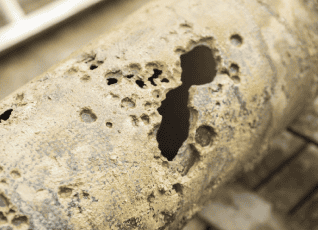
What is corrosion? Corrosion is the degradation or deterioration of a material caused by a reaction to its environment. In building plumbing systems, corrosion can occur in our piping systems and water-bearing equipment due to reactions, chemicals, and impurities in the water. These processes result in uniform corrosion, pitting, cracking, or erosion, ultimately causing the breakdown and failure of the piping system and components. How does it impact plumbing? Corrosion significantly impacts the plumbing system, operations, maintenance, costs, and equipment. It can lead to pinhole leaks in the piping and pipe blowouts, which can ultimately cause water damage to the surrounding area. Corrosion can also cause loss of efficiency, reduction in performance, blockages, and total equipment failure of valves, pipes, pumps, and heaters. All corrosion impacts have significant financial consequences, including pipe and equipment replacement, labor for repairs, maintenance and system interruptions, and downtime. What causes it? The corrosivity and corrosion rate of our building’s water systems depends on several water characteristics, including sediment levels, flow, temperature, chemical treatment programs, and microbial communities. How can it be controlled? Avoiding corrosive water treatment methods, such as chlorine, chlorine dioxide, and monochloramine, will significantly impact the life of plumbing systems. An alternative technology, copper-silver ionization, has greater efficacy against waterborne pathogens and does not increase the corrosivity of the water system. Installing a sediment filtration system on the incoming water supply will significantly reduce the amount of sediment entering the building water system. This protects the water system from sediment accumulation, which can lead to corrosion of equipment and pipes. The filtration system will also protect against external disruptions or surges in sediment, which can build up in a system, erode equipment, and impact equipment life. Case study: Colorado hospital sediment filtration success story Sediment in the incoming water supply caused pinhole leaks, forcing the replacement of two-year-old piping for $80K. Installing a LiquiTech™ Sediment Filtration System reduced sediment entering the building’s water system. Read the full case study here. Sediment levels (96.7% reduction) Download: corrosion fact sheet Fill out the form below to download our corrosion fact sheet to keep on hand or to share with your team.
Biofilm: What Is It and How to Control It
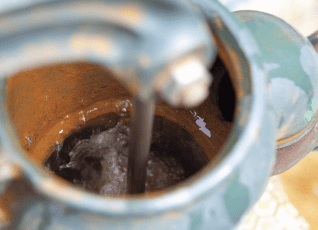
Biofilms, intricate communities of microorganisms including bacteria, fungi, and other microscopic entities, thrive on surfaces through a remarkable process of collaboration and self-protection. Encased within a self-produced, slime-like matrix, these microorganisms firmly anchor themselves to a variety of surfaces, from the moist lining of a water pipe to the hard enamel of our teeth. While often associated with wet environments, biofilms can also adapt to less moist conditions, revealing their resilience and versatility. In this article, we’ll explore what biofilms are, where they’re found, the health concerns associated with them, and how to control them in building water systems. Definition of biofilm Biofilms are composed of different types of microorganisms, including bacterial and fungal species, that grow on and stick to the surface of a structure. A biofilm may cover natural surfaces, like teeth, or manufactured surfaces, like water pipes or water storage systems. The microorganisms that make up biofilm can be in different states, including actively multiplying, dormant, or simply associated with the biofilm structure. They can also exhibit varied phenotypes, including differences in growth rate, gene expression, and resistance mechanisms. Formation of biofilms The microorganisms in biofilms are often embedded in a self-produced matrix of extracellular polymeric substances, which provides structural support and protection. This matrix contains living and dead cells and resists antimicrobial agents like sterilants, disinfectants, and antibiotics, shielding the microbial cells within. Where biofilms are found “Wet” biofilms typically develop in aqueous environments, including natural bodies of water like rivers and oceans, as well as manufactured surfaces like water pipes, storage tanks, and wastewater treatment facilities. “Dry” biofilms are found in less moist environments. They can develop on surfaces in healthcare settings (e.g., operating rooms), on skin or food surfaces, and in indoor environments (e.g., HVAC systems). Health concerns associated with biofilms Biofilms can harbor and protect waterborne pathogens, making them more disinfectant-resistant. They are implicated in a wide range of infections, such as urinary tract infections, middle-ear infections, and implant-associated infections. Biofilms can also exacerbate chronic wounds and lung infections in cystic fibrosis patients. Bacteria in biofilms are often more resistant to antibiotics, complicating the treatment of infections. How biofilms affect plumbing systems In plumbing systems, biofilms can reduce water flow, clog pipes, and corrode plumbing materials. They can also degrade water quality by harboring waterborne pathogens and releasing them into the water supply during events that alter water pressure and flow, like nearby construction or water main breaks. Controlling biofilms in building water systems Regular maintenance, routine flushing, and cleaning of pipes can help control biofilms. Some continuous supplemental disinfectants like copper-silver ionization can penetrate biofilms, killing the microbes contained inside. Physical treatments on the incoming water supply, like UV disinfection and sediment filtration, can help prevent microbes and nutrient-containing sediment from entering the building water system and contributing to new biofilm growth. When designing new building water systems, plumbing engineers should implement designs that reduce stagnation and ensure consistent water flow to help prevent biofilms from forming. Biofilms are a common and potentially harmful occurrence in building water systems. Proper maintenance and control can help prevent health concerns associated with biofilms and keep plumbing systems functioning properly. By understanding what biofilms are, where they’re found, and how to control them, organizations can ensure the safety and quality of their building’s drinking water.